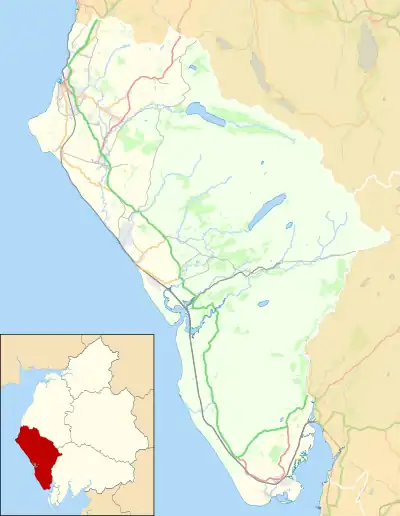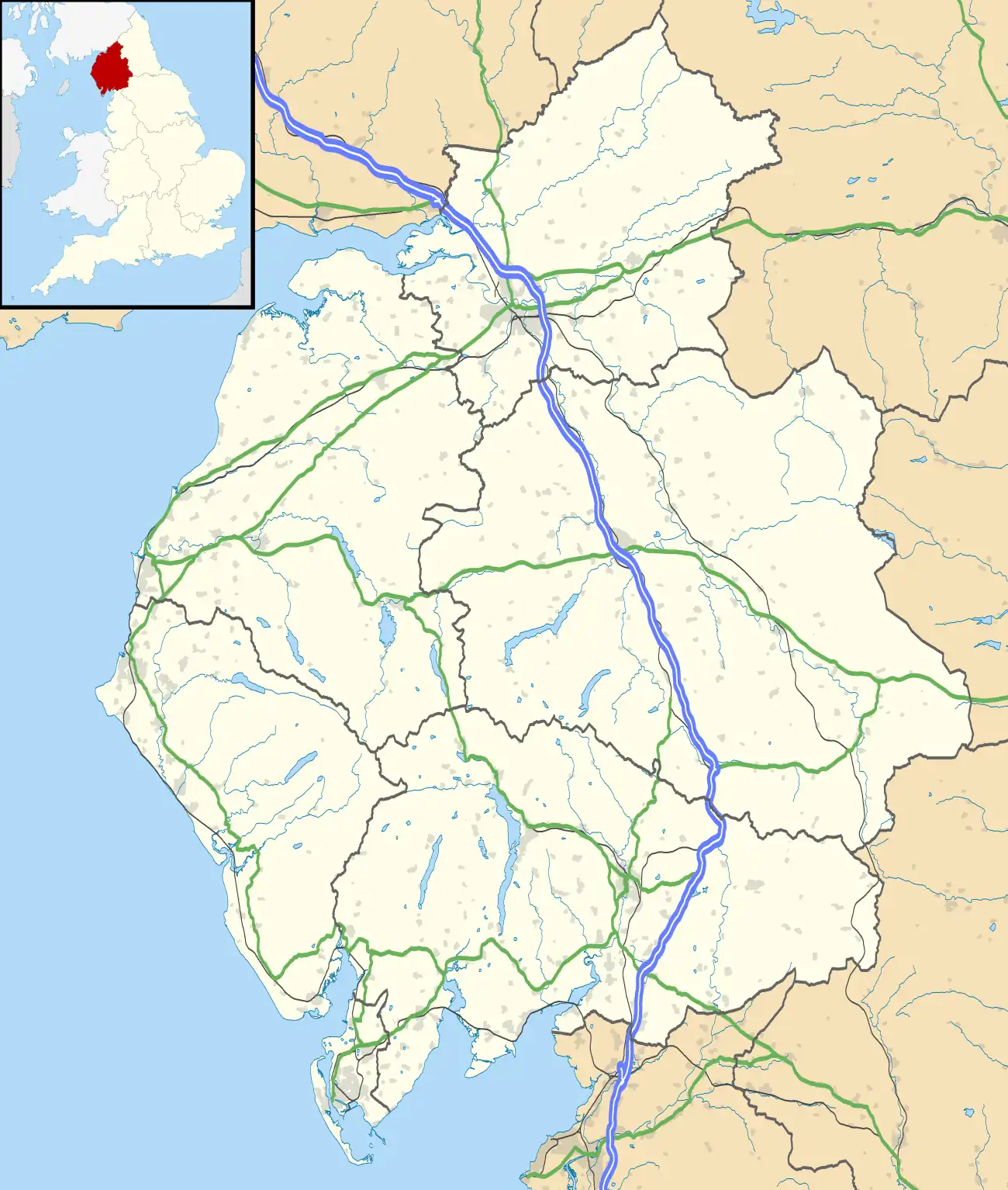Cleator Moor has had three passenger stations:
- The original 1857 Cleator Moor station which became a goods station when it was replaced in 1866. Its 1866 replacement which went on to be known as Cleator Moor East, and the rival 1879 station which went on to be known as Cleator Moor West.
Cleator Moor East | |
|---|---|
| General information | |
| Location | Cleator Moor, Copeland England |
| Coordinates | 54°31′31″N 3°31′41″W / 54.5254°N 3.5281°W |
| Grid reference | NY011155 |
| Platforms | 2[1] |
| Other information | |
| Status | Disused |
| History | |
| Original company | Whitehaven, Cleator and Egremont Railway |
| Pre-grouping | LNWR & FR Joint Railway |
| Post-grouping | London, Midland and Scottish Railway |
| Key dates | |
| 1866 | Opened as "Cleator Moor", replaced original station[2] |
| 2 June 1924 | Renamed "Cleator Moor East" |
| 13 April 1931 | Closed to passengers[3] |
| 11 March 1940 | Reopened to workmen's trains[4] |
| 8 April 1940 | Closed |
| Location | |
 Cleator Moor East Location in present-day Copeland Borough  Cleator Moor East Location in present-day Cumbria | |

Whitehaven, Cleator & Egremont Railway | |||||||||||||||||||||||||||||||||||||||||||||||||||||||||||||||||||||||||||||||||||||||||||||||||||||||||||||||||||||||||||||||||||||||||||||||||||||||||||||||||||||||||||||||||||||||||||||||||||||||||||||||||||||||||||||||||||||||||
|---|---|---|---|---|---|---|---|---|---|---|---|---|---|---|---|---|---|---|---|---|---|---|---|---|---|---|---|---|---|---|---|---|---|---|---|---|---|---|---|---|---|---|---|---|---|---|---|---|---|---|---|---|---|---|---|---|---|---|---|---|---|---|---|---|---|---|---|---|---|---|---|---|---|---|---|---|---|---|---|---|---|---|---|---|---|---|---|---|---|---|---|---|---|---|---|---|---|---|---|---|---|---|---|---|---|---|---|---|---|---|---|---|---|---|---|---|---|---|---|---|---|---|---|---|---|---|---|---|---|---|---|---|---|---|---|---|---|---|---|---|---|---|---|---|---|---|---|---|---|---|---|---|---|---|---|---|---|---|---|---|---|---|---|---|---|---|---|---|---|---|---|---|---|---|---|---|---|---|---|---|---|---|---|---|---|---|---|---|---|---|---|---|---|---|---|---|---|---|---|---|---|---|---|---|---|---|---|---|---|---|---|---|---|---|---|---|---|---|---|---|---|---|---|---|---|---|---|---|---|---|---|---|---|
| |||||||||||||||||||||||||||||||||||||||||||||||||||||||||||||||||||||||||||||||||||||||||||||||||||||||||||||||||||||||||||||||||||||||||||||||||||||||||||||||||||||||||||||||||||||||||||||||||||||||||||||||||||||||||||||||||||||||||
Cleator Moor East railway station was the second station built by the Whitehaven, Cleator and Egremont Railway in the growing industrial town of Cleator Moor, Cumbria, England.[5][6]
History
The line was one of the fruits of the rapid industrialisation of West Cumberland in the second half of the nineteenth century. The original Cleator Moor station opened to passengers on 1 July 1857 on the line being developed from Moor Row to Rowrah.
Subsidence led the company to build a deviation line which curved round the west side of the original station and the growing settlement, in a similar manner to what it was forced to do at Eskett a few miles to the east. They built a passenger station on the deviation line - known locally as "The Bowthorn Line"[7] - which would go on to be called Cleator Moor East.
When the deviation line and station opened in 1866 the original station was closed to passengers and became "Cleator Moor Goods Depot." It remained open for goods traffic until the 1950s.
Services
Whilst some Whitehaven, Cleator and Egremont Railway (WCER) mineral, goods and passenger traffic to and from Rowrah passed north along the line to Marron Junction, the greater part arrived and left southwards towards Moor Row and therefore passed through Cleator Moor. Mineral traffic was also generated locally from the quarries and mines such as the Iron Works within sight of the station.
In 1922 seven all stations passenger trains called at Cleator Moor East in each direction, with an extra on Whitehaven Market Day. Four were Rowrah to Whitehaven services, the other three plied a long, circuitous route between Workington Main and Whitehaven via Camerton, Marron Junction, Ullock, Rowrah and Moor Row.[8]
Cleator Moor East station's owning Whitehaven, Cleator and Egremont company was taken over by the LNWR and Furness Railway in 1879 as a Joint Line, whereafter the section through the station was usually worked by the LNWR.[9]
Goods traffic typically consisted of a two daily turns Up and Down.
Mineral traffic was the dominant flow, though this was subject to considerable fluctuation with trade cycles. Stations and signalling along the line south of Rowrah were changed during the Joint regime to conform to Furness Railway standards.[10]
Rundown and closure
The station closed on 13 April 1931 when normal passenger traffic ended along the line, though workmen's trains were reinstated in March 1940, only to be withdrawn a month later. An enthusiasts' special ran through on 5 September 1954. After scant occasional use the line northwards from Rowrah was abandoned in 1960 and subsequently lifted.[11]
The line southwards from Rowrah through Cleator Moor East lead a charmed life, continuing with a limestone flow from a quarry at Rowrah until 1978, after which all traffic ceased and the tracks were lifted.[12]
Afterlife
By 2013 the station appeared to have been demolished and some of the trackbed had become a Public Open Space.
| Preceding station | Disused railways | Following station | ||
|---|---|---|---|---|
| Frizington Line and station closed |
Whitehaven, Cleator and Egremont Railway | Moor Row Line and station closed |
See also
References
- ↑ Suggitt 2008, p. 54.
- ↑ Suggitt 2008, p. 52.
- ↑ Butt 1995, p. 63.
- ↑ Croughton, Kidner & Young 1982, p. 59.
- ↑ Smith & Turner 2012, Map 26.
- ↑ Jowett 1989, Map 36.
- ↑ Joy 1983, p. 166.
- ↑ Bradshaw 1985, p. 510.
- ↑ McGowan Gradon 2004, p. 12.
- ↑ "W McGowan Gradon's 1942 Furness Railway study, via cumberlandarchives.co.uk". Archived from the original on 26 January 2016. Retrieved 8 January 2016.
- ↑ Atterbury 2009, p. 208.
- ↑ Suggitt 2008, p. 59.
Sources
- Atterbury, Paul (2009). Along Lost Lines. Newton Abbot: David & Charles. ISBN 978-0-7153-2706-7.
- Bradshaw, George (1985) [July 1922]. Bradshaw's General Railway and Steam Navigation guide for Great Britain and Ireland: A reprint of the July 1922 issue. Newton Abbot: David & Charles. ISBN 978-0-7153-8708-5. OCLC 12500436.
- Butt, R. V. J. (October 1995). The Directory of Railway Stations: details every public and private passenger station, halt, platform and stopping place, past and present (1st ed.). Sparkford: Patrick Stephens Ltd. ISBN 978-1-85260-508-7. OCLC 60251199. OL 11956311M.
- Croughton, Godfrey; Kidner, Roger W.; Young, Alan (1982). Private and Untimetabled Railway Stations, Halts and Stopping Places X 43. Headington, Oxford: The Oakwood Press. ISBN 0-85361-281-1.
- Jowett, Alan (March 1989). Jowett's Railway Atlas of Great Britain and Ireland: From Pre-Grouping to the Present Day (1st ed.). Sparkford: Patrick Stephens Ltd. ISBN 978-1-85260-086-0. OCLC 22311137.
- Joy, David (1983). Lake Counties (Regional History of the Railways of Great Britain). Newton Abbot: David & Charles. ISBN 094653702X.
- McGowan Gradon, W. (2004) [1952]. The Track of the Ironmasters: A History of the Cleator and Workington Junction Railway. Grange-over-Sands: Cumbrian Railways Association. ISBN 0-9540232-2-6.
- Smith, Paul; Turner, Keith (2012). Railway Atlas Then and Now. Ian Allan Publishing. ISBN 978-0-7110-3695-6.
- Suggitt, Gordon (2008). Lost Railways of Cumbria (Railway Series). Newbury: Countryside Books. ISBN 978-1-84674-107-4.
Further reading
- British Railways Pre-Grouping Atlas And Gazetteer. Shepperton: Ian Allan Publishing. 1997 [1958]. ISBN 0-7110-0320-3.
- Anderson, Paul (April 2002). Hawkins, Chris (ed.). "Dog in the Manger? The Track of the Ironmasters". British Railways Illustrated. Clophill: Irwell Press Ltd. 11 (7).
- Bairstow, Martin (1995). Railways In The Lake District. Martin Bairstow. ISBN 1-871944-11-2.
- Bowtell, Harold D. (1989). Rails through Lakeland: An Illustrated Journey of the Workington-Cockermouth-Keswick-Penrith Railway 1847-1972. Wyre, Lancashire: Silverling Publishing Ltd. ISBN 0-947971-26-2.
- Marshall, John (1981). Forgotten Railways: North West England. Newton Abbot: David & Charles. ISBN 0-7153-8003-6.
- Western, Robert (2001). The Cockermouth, Keswick and Penrith Railway OL113. Usk: Oakwood Press. ISBN 0-85361-564-0.
External links
- Map of the line with photos, via RAILSCOT
- The station on overlain OS maps surveyed from 1898, via National Library of Scotland
- All three closed stations on a 1948 OS Map, via npe maps
- The station, via Rail Map Online
- Cleator Moor East station and deviation line, via railwaycodes
- The railways of Cumbria, via Cumbrian Railways Association
- Photos of Cumbrian railways, via Cumbrian Railways Association
- The railways of Cumbria, via Railways_of_Cumbria
- Cumbrian Industrial History, via Cumbria Industrial History Society
- The line's and station's Engineer's Line References, via railwaycodes.org.uk
- Furness Railtour using many West Cumberland lines 5 September 1954, via sixbellsjunction
- A video tour-de-force of the region's closed lines, via cumbriafilmarchive
- 1882 RCH Diagram showing the station, see page 173 of the pdf, via google
- Haematite, via earthminerals